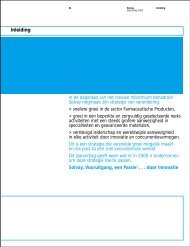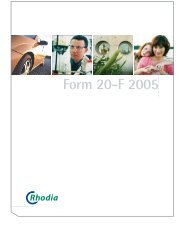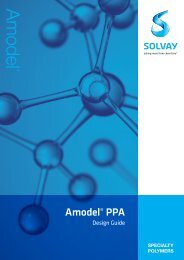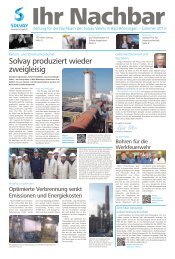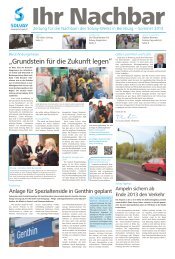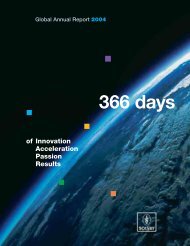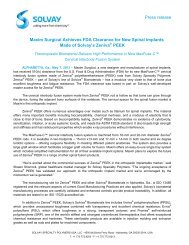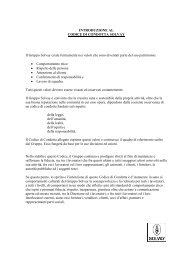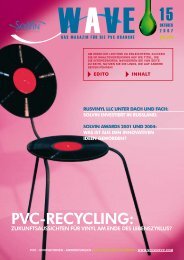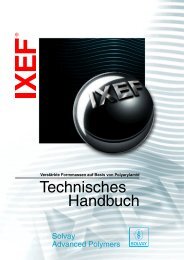Jump into the PVC car - Solvay Plastics
Jump into the PVC car - Solvay Plastics
Jump into the PVC car - Solvay Plastics
You also want an ePaper? Increase the reach of your titles
YUMPU automatically turns print PDFs into web optimized ePapers that Google loves.
Des Markets produits, and Products des marchés<br />
<strong>Jump</strong> <strong>into</strong> <strong>the</strong><br />
<strong>PVC</strong> <strong>car</strong><br />
Citroën<br />
After losing speed during <strong>the</strong> 1990s, <strong>PVC</strong> is racing back <strong>into</strong> <strong>the</strong> <strong>car</strong> market. Its ideal performances in certain<br />
applications and its very competitive cost make it an ideal material for motor vehicle manufacturers.<br />
The <strong>car</strong> industry is a major market<br />
for <strong>PVC</strong>, purchasing 50 Kt/year<br />
of compounds in Europe 1 . An<br />
average <strong>car</strong> contains 10-15 kg of <strong>PVC</strong>,<br />
in a wide range of applications. <strong>Jump</strong> in<br />
for a demonstration.<br />
Open <strong>the</strong> door, sit inside and you can<br />
easily spot <strong>the</strong> <strong>PVC</strong>, used mainly to<br />
increase comfort and for decoration. Its<br />
main use is for dashboards, but we also<br />
fi nd it on doors, arm-rests, seats, sun<br />
visors, gearstick covers and sometimes<br />
in <strong>the</strong> protective <strong>car</strong>pets, in <strong>the</strong> form<br />
of one or more layers of compact<br />
<strong>PVC</strong>, foamed <strong>PVC</strong> or in combination<br />
with polyurethane fi lms and/or coated<br />
textiles.<br />
<strong>PVC</strong> formulations can easily be adapted<br />
to suit <strong>the</strong> requirements for each<br />
application: a fi lm intended for a seat, for<br />
example cannot be <strong>the</strong>rmoformed <strong>into</strong> a<br />
<strong>car</strong> dashboard. Climatic conditions in <strong>the</strong><br />
country where <strong>the</strong> vehicle is to be sold<br />
are also taken <strong>into</strong> account, to enable<br />
<strong>the</strong> <strong>PVC</strong> to withstand extremes of heat<br />
or cold. “For those parts exposed to <strong>the</strong><br />
sun, especially dashboards and doors, <strong>car</strong>e<br />
is needed to avoid ‘fogging’. A few years<br />
ago it was noticed that new <strong>PVC</strong> coverings<br />
(Editor’s note: o<strong>the</strong>r plastics suffer <strong>the</strong> same<br />
problem) tended to deposit an oily fi lm<br />
on <strong>car</strong> windows as additives evaporated.<br />
Today manufacturers have become very<br />
strict on this point. So we have put in a<br />
lot of work in R&D to remedy this”, points<br />
out Françoise Brisse, R&D and Quality<br />
Manager at Atlas innovations, a company<br />
that produces <strong>the</strong>se fi lms 2 .<br />
“The colours are invariably neutral, in<br />
particular grey. Right now we are seeing<br />
a trend towards very matt fi nishes”, she<br />
explains to Wave. “We take advantage<br />
of <strong>the</strong> opportunities <strong>PVC</strong> offers to move<br />
on from imitation lea<strong>the</strong>r to more technical<br />
grain effects with o<strong>the</strong>r textures. For<br />
example, <strong>the</strong> metallic look of <strong>the</strong> passenger<br />
compartment of <strong>the</strong> Citroen C3 Pluriel.”<br />
O<strong>the</strong>r competing materials for <strong>the</strong>se<br />
applications are TPU (<strong>the</strong>rmoplastic<br />
polyurethane), TP (<strong>the</strong>rmoplastic<br />
polyolefi n) and lea<strong>the</strong>r for certain topof-<strong>the</strong>-range<br />
vehicles.<br />
Dashboards<br />
<strong>PVC</strong> is popular for dashboards because<br />
of its ease of processing in <strong>the</strong> “slush<br />
moulding” process, which offers an<br />
easy way of producing complex shapes.<br />
The negative mould of <strong>the</strong> dashboard,<br />
containing <strong>the</strong> fi nishing grain, is fi rst<br />
heated to around 220° C. <strong>PVC</strong> powder<br />
is <strong>the</strong>n poured in. The powder melts and<br />
<strong>the</strong> mould is turned in every direction<br />
to ensure that <strong>the</strong> <strong>PVC</strong> reaches every<br />
corner of <strong>the</strong> mould, before <strong>the</strong> surplus<br />
is drained from <strong>the</strong> mould. This results<br />
in a uniform layer of ca 1mm left on<br />
<strong>the</strong> entire surface of <strong>the</strong> mould, which<br />
The heavyweights<br />
of weight<br />
reduction<br />
<strong>PVC</strong> can be used to imitate lea<strong>the</strong>r, but also to obtain o<strong>the</strong>r effects. The Lancia Thesis<br />
dashboard is slush moulded in <strong>PVC</strong> by equipment manufacturer Visteon.<br />
Visteon<br />
<strong>Plastics</strong> are certainly a “heavy” argument<br />
for making vehicles lighter and<br />
reducing fuel consumption. Appearing<br />
for <strong>the</strong> fi rst time in <strong>the</strong> 1960s,<br />
today <strong>the</strong>y make up about 20%<br />
of a vehicle’s weight, i.e. generally<br />
between 170 and 260 kg. The most<br />
widely used polymers (elastomers,<br />
<strong>the</strong>rmoplastics, <strong>the</strong>rmosetting resins<br />
and composites) today are <strong>the</strong> polyolefi<br />
ns PP and PE, polyurethanes<br />
(PUR), <strong>PVC</strong> – up to 10 to 15 kg per<br />
<strong>car</strong> – and acrylonitrile-butadienestyrene<br />
(ABS) 4 .<br />
8<br />
1<br />
SolVin estimate (not including <strong>car</strong> seats)<br />
2<br />
The main European companies that manufacture <strong>PVC</strong> foils for <strong>car</strong>s are Benecke-Kaliko (Germany), Vulcafl ex<br />
(Italy), Sioen (Belgique), Mecaseat, Atlas innovations, Yeramex (France).<br />
3<br />
The 3 main European producers of compounds used in <strong>car</strong>s are ATO, <strong>Solvay</strong> and LVM.<br />
4<br />
Source: Étude prospective Plasturgie automobile pour le Nord-Pas de Calais, ADIT, 2003
Dashboards are one of <strong>the</strong> main applications<br />
for <strong>PVC</strong> in <strong>car</strong>s today.<br />
is heated for a few seconds to complete<br />
<strong>the</strong> gelation. The mould is <strong>the</strong>n cooled<br />
and <strong>the</strong> new “skin” is removed, placed<br />
on <strong>the</strong> dashboard (for example in PP).<br />
A polyurethane foam is <strong>the</strong>n injected<br />
between <strong>the</strong> materials to bond <strong>the</strong>m<br />
toge<strong>the</strong>r and make <strong>the</strong> dashboard<br />
comfortable to <strong>the</strong> touch.<br />
This technique has been in use since <strong>the</strong><br />
1980s, and is now so successful that it<br />
is used to produce almost 80% of all<br />
dashboards, with demand continuing<br />
to increase 3 . “Carmakers like BMW and<br />
Renault, s<strong>car</strong>ed away in recent years by<br />
<strong>the</strong> bad environmental image propagated<br />
by <strong>the</strong> anti-<strong>PVC</strong> lobbies, are coming back”,<br />
according to Christian Popin, a specialist<br />
in <strong>the</strong> automobile market at <strong>PVC</strong><br />
compound producer Benvic.<br />
“We have a project for <strong>the</strong> end of 2005<br />
for <strong>the</strong> new BMW X3 and X5 for <strong>the</strong><br />
US market and ano<strong>the</strong>r in 2006 for <strong>the</strong><br />
European market.” A fur<strong>the</strong>r example of<br />
this return to favour is <strong>the</strong> fact that since<br />
July 2004 Benoac (Benecke group) has<br />
Did you know?<br />
How much <strong>PVC</strong> is <strong>the</strong>re in a <strong>car</strong>?<br />
An Audi A8 has been calculated to<br />
contain 15.3 kg, comprising 5.4 kg<br />
of cable sheathing, 4 kg of fi lms and<br />
moulded iparts, 0.9 kg of dashboard<br />
covering and 5 kg of mastic sealant.<br />
been supplying more than 2000 skins a<br />
day for <strong>the</strong> dashboard of <strong>the</strong> new Ford<br />
Focus. A record order worth 25 million<br />
euros over 6 years. Luxury vehicles like<br />
Jaguars and <strong>the</strong> Porsche Cayenne are<br />
also fi tted with <strong>PVC</strong> skins.<br />
In place of <strong>the</strong> slush technique,<br />
less complex dashboards can<br />
also be fi nished with simple<br />
<strong>the</strong>rmoformed <strong>PVC</strong> foil (for<br />
cheaper <strong>car</strong>s) or lined with a<br />
layer of <strong>PVC</strong> foam to obtain<br />
a softer touch.<br />
Comfortably<br />
seated<br />
Being a good seat<br />
covering and having<br />
<strong>the</strong> honour of welcoming<br />
passengers’<br />
Faurecia<br />
posteriors is a tall<br />
order. The <strong>PVC</strong> must<br />
be easy to sew, supple to resist threading<br />
on <strong>the</strong> seat, not create folds nor crack<br />
under <strong>the</strong> passengers’ weight, be resistant<br />
to abrasion, stains and also cleaning.<br />
This is also where <strong>PVC</strong> comes <strong>into</strong> its<br />
own, allowing many fi nishing effects.<br />
Cable sheathing<br />
O<strong>the</strong>r <strong>PVC</strong> applications in <strong>car</strong>s are<br />
much less visible, indeed many of <strong>the</strong>m<br />
you would never suspect existed.<br />
One of <strong>the</strong> main applications is for<br />
sheathing low voltage electrical cables.<br />
Here <strong>PVC</strong> offers major advantages: good<br />
fi re and low temperature<br />
resistance, easy processing,<br />
low cost, and <strong>the</strong> possibility<br />
of recycling by <strong>the</strong><br />
Vinyloop ® process. Here<br />
too, after diffi cult times<br />
between 1995-2000,<br />
when manufacturers<br />
turned towards PE or<br />
PP, <strong>PVC</strong> is back in <strong>the</strong><br />
race. All <strong>the</strong> more so<br />
since, whilst <strong>PVC</strong> has<br />
traditionally been used<br />
for classes 1 (passenger<br />
compartments) and<br />
2 applications, <strong>PVC</strong><br />
compounds now meet<br />
category 3 requirements.<br />
“To be accepted in this category,<br />
<strong>the</strong> cable has to pass testing in<br />
what are extreme conditions for <strong>PVC</strong>:<br />
being kept at 150°C for 10 days and <strong>the</strong>n<br />
being spooled at -40°C without cracking”,<br />
Christian Popin explains.<br />
Under <strong>the</strong> bonnet, <strong>PVC</strong>, which also<br />
offers good abrasion resistance, is used<br />
as protection or a retractable sleeve to<br />
streng<strong>the</strong>n <strong>the</strong> durits (tubes used to<br />
Citroën<br />
PSA<br />
Audi<br />
Apart from its use for door coverings, <strong>PVC</strong> can<br />
be expanded with blowing agents, which act<br />
like baking soda in a cake, <strong>into</strong> foam fi lling for<br />
doors and sun visors.<br />
Here <strong>PVC</strong> foam under <strong>the</strong><br />
microscope.<br />
9
Markets and Products<br />
PSA<br />
<strong>PVC</strong> is applied during bodywork<br />
assembly onto parts at risk from<br />
stone chipping, to stop <strong>the</strong> paint<br />
from fl aking and <strong>the</strong> bodywork<br />
from rusting.<br />
<strong>car</strong>ry liquids between <strong>the</strong> different parts<br />
of <strong>the</strong> engine).<br />
Body armour<br />
<strong>PVC</strong> is also used in ano<strong>the</strong>r application<br />
which, being invisible, is unknown to your<br />
average driver. As “mastic” it is applied<br />
to <strong>the</strong> sensitive parts of <strong>the</strong> bodywork,<br />
for example to <strong>the</strong> welds of <strong>the</strong> engine<br />
compartment, where it protects against<br />
oxidation; under <strong>the</strong> body to make <strong>the</strong><br />
passenger compartment damp, dust<br />
and fume-proof, and to parts at risk<br />
from stone chipping. Plastisol, a mixture<br />
of <strong>PVC</strong> and plasticisers, is pulverised<br />
onto <strong>the</strong> bodywork before <strong>the</strong> fi rst<br />
coat of paint. The two layers are <strong>the</strong>n<br />
stoved simultaneously. “At least 90% of<br />
manufacturing sites use <strong>PVC</strong> mastic, which<br />
is cheaper than polyurethane mastic and<br />
more effective than bitumen”, Hermann<br />
Eichholz from SolVin Customer Technical<br />
Services <strong>PVC</strong> Emulsion told Wave.<br />
Sealing<br />
We fi nish this guided tour with a few<br />
more applications. The joints of <strong>the</strong> fi xed<br />
windows and <strong>the</strong> back window also use<br />
<strong>PVC</strong>, in particular in North America (18<br />
to 20 kt/year) and Japan. Using <strong>the</strong> socalled<br />
encapsulation technique, perfect<br />
waterproofi ng is obtained by injecting<br />
<strong>PVC</strong> <strong>into</strong> a mould which represents<br />
exactly <strong>the</strong> space between <strong>the</strong> glass and<br />
<strong>the</strong> <strong>car</strong> wall.<br />
Whilst <strong>the</strong> <strong>PVC</strong> protective strips along<br />
<strong>the</strong> sides of <strong>car</strong> bodies have in most<br />
cases been replaced by PP, <strong>the</strong> roof<br />
profi les (<strong>the</strong> fi ne black or coloured strip<br />
running above <strong>the</strong> doors) in many cases<br />
remain in <strong>PVC</strong>.<br />
Finally, <strong>PVC</strong> can also be used for <strong>the</strong><br />
roofs and side and rear windows of<br />
convertibles and cross-country vehicles.<br />
After some rough driving in <strong>the</strong><br />
1990s, it looks like a straight road<br />
ahead for <strong>PVC</strong>.<br />
■<br />
Intermodal<br />
transport<br />
award for<br />
SolVin Italia<br />
SolVin has just won <strong>the</strong> 5 th<br />
Intermodal Award of <strong>the</strong> European<br />
Intermodal Association for its<br />
SIRIO (SolVin Italia Railway<br />
Intermodal Operations) rail-road<br />
transportation system. SolVin <strong>PVC</strong><br />
for Italy is brought in by train to<br />
two depots near Milan, and <strong>the</strong>n<br />
forwarded on to customers by<br />
road. As well as putting SolVin Italia<br />
ahead of <strong>the</strong> competition in terms<br />
of logistics excellence (punctuality<br />
and lack of contamination), this<br />
system also brings environment<br />
benefi ts, cutting out 10,000 trans-<br />
Alpine truck journeys and saving<br />
2.4 million litres of diesel every<br />
year.<br />
10<br />
Daimler Chrysler<br />
The Chrysler Sebring Convertible 2005, which is proving a great success in <strong>the</strong> United<br />
States, has an electrically controlled <strong>PVC</strong> hood incorporating <strong>the</strong> roof, side and rear<br />
windows.<br />
On 2 November 2004, <strong>the</strong><br />
European Intermodal Association<br />
(E.I.A.) handed <strong>the</strong> Intermodal<br />
Award to SolVin Italia’s Managing<br />
Director Paolo Groppi. The EIA,<br />
which is supported by <strong>the</strong> European<br />
Commission and Parliament, seeks to<br />
promote intermodal transport and to<br />
develop best practice in this fi eld.



